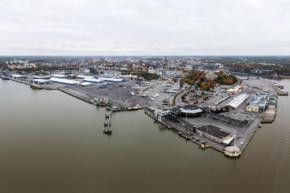Maritime logistics is facing changes
The future of maritime logistics is exceptionally important for Finland, and its effects cover a wide range including the economy and environment. Nearly 90 per cent of Finland’s foreign trade is carried by sea, and the share is still growing as the war in Ukraine stopped a large portion of the transports across Finland’s eastern border. As a result, it became necessary to find alternative routes for cargo, and the volume of goods transports in the Baltic Sea has decreased. That is visible in container transports in particular, where the elimination of a large port such as St. Petersburg from the rotation has also affected the container transports destined to Finnish ports.

The challenges caused by the war in Ukraine are a continuation of the consequences of the pandemic. As a result, the container transports between Asia and the rest of the world quieted down, transports slowed down, and the ports became congested, which was also reflected in the functioning of international supply chains. For example, the availability of components for technology suffered, and the delivery times were also prolonged for end customers. The effects of the pandemic were also sizeable in passenger traffic, as international passenger traffic came to an almost complete stop and is only now returning to its normal level. Exceptional times continue in the Baltic Sea cruise traffic due to the war in Ukraine.
According to all forecasts, however, maritime logistics are still growing. The scenarios do not indicate that we would be going from globalisation back to localisation, but the international division of work continues to strengthen. The growing volume of goods means larger vessel sizes, which will present its own challenges, for example, the handling capacity of ports. The key question is, how the rest of the supply chain will adapt to the situation in which the economics of scale guide the development in one area of the chain.
The biggest challenge to the development of maritime logistics is, however, formed by environmental questions. Decisions aimed at decreasing the emissions of maritime transports have been made both at the EU level and by the International Maritime Organization IMO. The European Union has decided to include seafaring in the emission trade system, and the goal of the proposed FuelEU Maritime regulation is to shift gradually to carbon-neutral fuels. IMO determines energy efficiency indexes for both new and existing ships (EEDI and EEXI), and sets gradually tightening requirements for the operational carbon intensity of vessels. In addition, IMO is currently discussing market-based means to decrease emissions to speed up the reduction of emissions in seafaring.
Reaching the goals to reduce emissions and completely carbon-neutral operations will increase the costs of maritime logistics at least in the short and medium term. The availability of carbon-neutral fuels will remain a question mark for a long time and, for example, all raw materials of biofuels are not compatible with the principles of sustainable development. In the production of hydrogen, the bottleneck is the production capacity of electricity.
Regarding the future of maritime logistics, there are many big environmental questions. The solutions can, however, be found through co-operation between different parties to which Finland and the Finnish maritime cluster have a lot to offer.
The writer of the column Tomi Solakivi is Assistant Professor at the University of Turku, specialising in operations and supply chain management.



